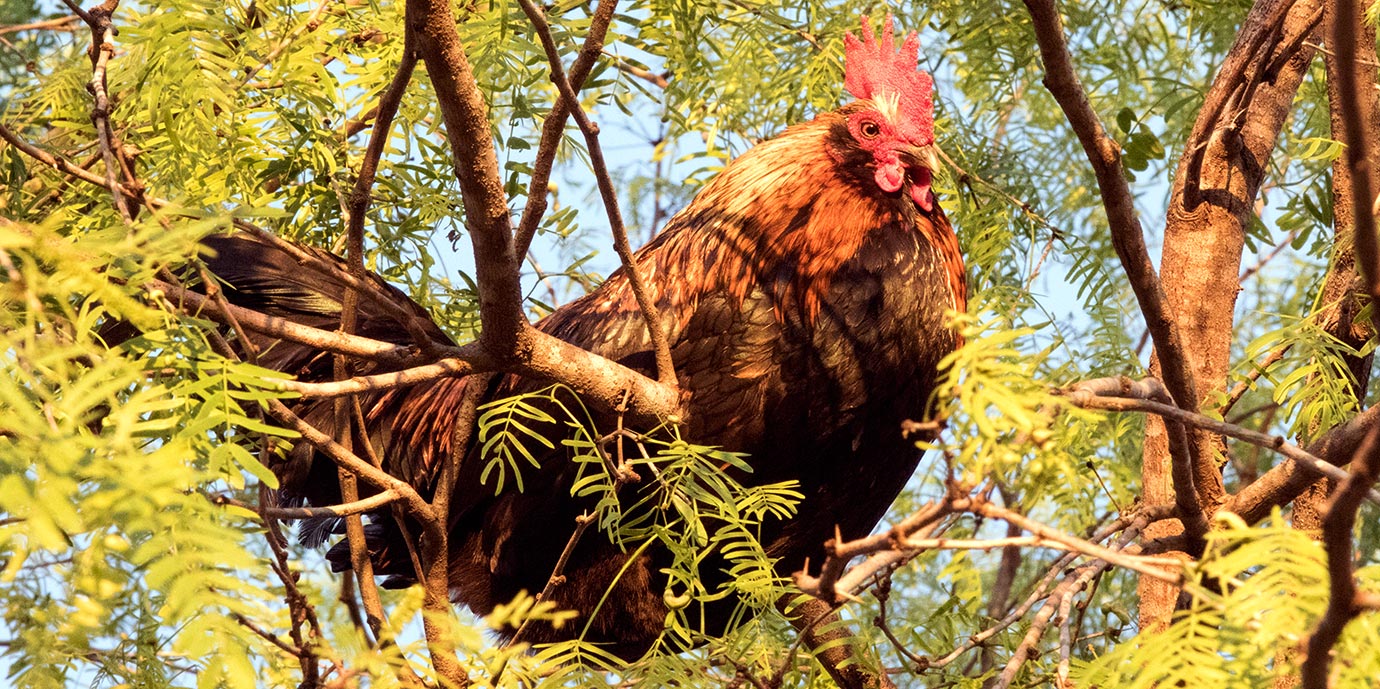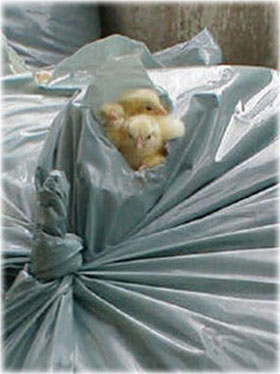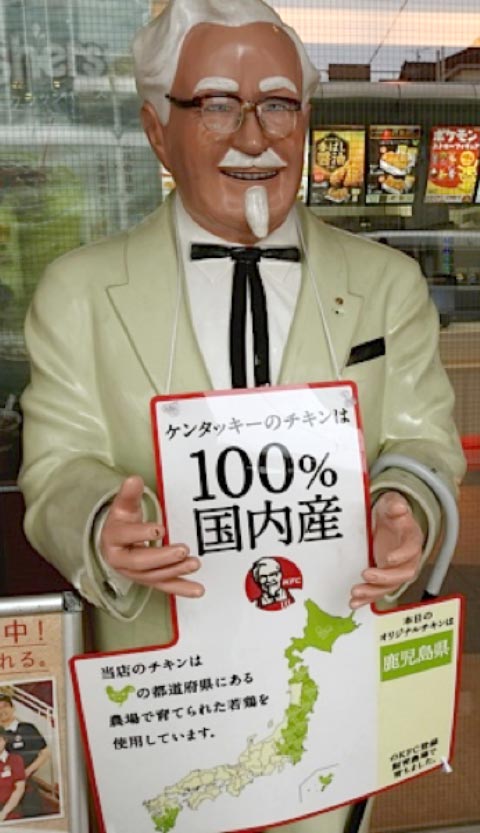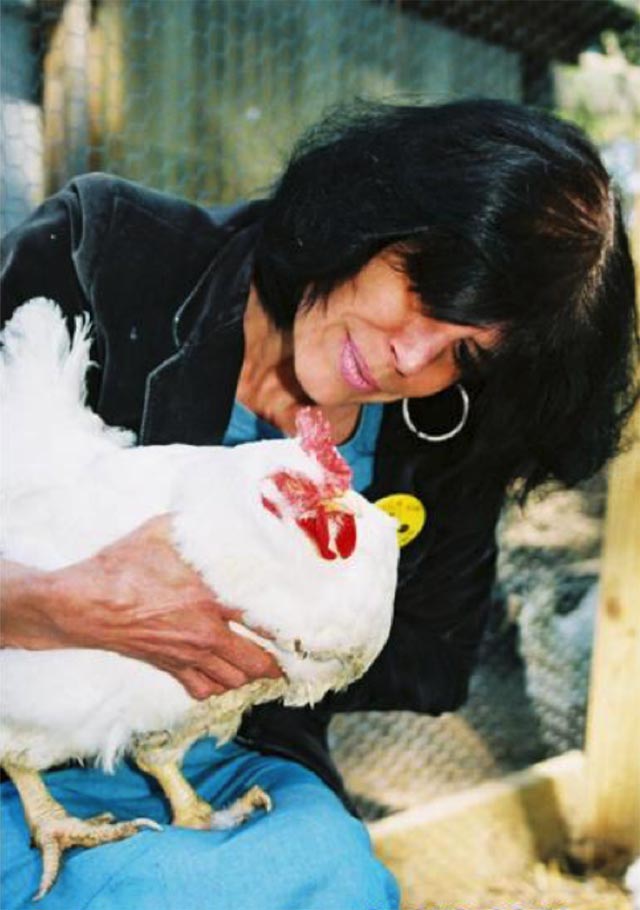This article, special to Animals 24-7,
was published by Animals 24-7 on June 24, 2016.
 This rooster is safe at SARA sanctuary in Sequin, Texas.
This rooster is safe at SARA sanctuary in Sequin, Texas.
Photo credit: Unparalleled Suffering Photography
Dear Animal Shelter, I see you have a rooster right now. I have a placement lined up for him and would like to pick him up Saturday.”
Animal Shelter: “Thanks for inquiring about the rooster. It’s great to know there is a potential placement for him. We’ve actually
just learned of a new development on the state level that will impact this guy’s availability.”
This is the gist of an email exchange in North Carolina in May. The rooster whose prospects were so promising, instead of going to a sanctuary, is now
dead, because the shelter killed him. Why?
No creature on earth more cursed
I will begin by saying that no creature on earth is more cursed than chickens are cursed by the human species. In the course of thousands of years,
chickens have gone from the tropical forest to the factory farm, with few good stops in between. Because factory farming is so incorrigibly cruel, some
people view the recent trend in backyard chicken-keeping as a humane alternative.
To the extent that backyard chickens awaken novices to the fact that chickens are lively, sociable individuals with intelligence and feelings, and insofar
as zoning laws allowing the keeping of a few chickens mean more homes for sanctuaries and shelters to place abandoned birds in, backyard-chicken-keeping
has benefitted chickens. Moreover, there is no question that a well-cared-for backyard chicken has a better life than a factory-farm chicken.
Backyard chicken-keeping fraught with problems
|
But those of us working in sanctuaries and shelters have also learned that backyard chicken-keeping is fraught with problems that link it to the industrial
world of poultry and egg production.
Most animal advocates are aware by now that the global egg industry destroys billions of male chicks as soon as they hatch. Countless more chickens,
turkeys, quails, ducks and other birds born in hatcheries are treated the same. Upon breaking out of their shells in the mechanical incubators, instead of
being sheltered by a mother hen’s wings and protected by a vigilant rooster, the newborn chicks are ground up alive, electrocuted, or thrown into
plastic-lined trashcans, sometimes being gassed with carbon dioxide in the cans as they slowly suffocate, peeping to death as a human foot stomps them down
to make room for more chicks.
|

Hatchery photo courtesy of The Animals Voice
|
“Ethical questions are raised when unwanted animals are brought into this world, diminishing our sense of the inherent value of the living
creature.”
– F. Barbara Orlans,
Senior Research Fellow at the Kennedy Institute of Ethics, Georgetown University
Destroying male chicks is an age-old farming practice. At an agribusiness meeting I once met a farmer who described to me the “old-fashioned”
method of running over male chicks with a truck. In an article in New Scientist, Ruth Harrison, author of the influential book Animal Machines in 1964, described “the old practice of filling up a dustbin with them and letting them suffocate.”
Market created for killing chickens
Since most ordinances allowing residents to have a few chickens allow hens but no roosters, a market is created for killing 50 percent or more of all
chicks born in the hatcheries. And since hatcheries have no use for them, they may stuff a couple of baby roosters into the box being shipped to the
customer along with the pullets (young hens), leaving the buyer to deal with the unexpected roosters.
Wild West
“I have long anticipated that the wild west climate of backyard chickens would come to the attention of producers and the agencies that
promote them.”
– Mary Britton Clouse, Chicken Run Rescue, June 4, 2016
Returning to the rooster in North Carolina who had a home ready for him, why did the shelter kill him? In an email exchange with the sanctuary on May 27,
2016, the shelter manager wrote: “The Veterinary Services division of the NC Department of Agriculture & Consumer Services (NCDA&CS) has
requested that shelters test all surrendered and seized poultry for a variety of reportable diseases that could adversely impact the state’s
agricultural flocks prior to making them available for placement.”
The manager explained that the NCDA&CS would cover the cost of testing for four reportable poultry diseases (infectious laryngotracheitis, mycoplasma
gallisepticum, mycoplasma synoviae, and avian influenza), and that any shelter bird testing positive for one or more of these diseases should be deemed
“unsuitable for placement.” And so it happened that this poor rooster, who tested positive for a mycoplasma synoviae infection, was killed by
the shelter on June 3rd instead of receiving the antibiotic treatment the sanctuary would have provided.
The North Carolina Department of Agriculture is not clamping down on animal shelters to protect public health or animal wellbeing. It is acting to protect
the economics of the poultry industry. This being so, Mary Britton Clouse, director of Chicken Run Rescue in Minneapolis, wondered in an email
correspondence in June: “Will all other random sources of poultry – Craigslist, live markets, poultry swaps, ad infinitum now be tested as
well? If not, why not?”
Chicken Production Breeds Chronic Disease
The conflict between backyard chickens and the chicken industry is not new. During the first half of the twentieth century, the growing poultry industry
consolidated in opposition to people keeping their own small flocks.
In the 1920s, hatcheries with artificial incubators and brooders became widespread. Mother hens no longer sat on their eggs. Poultry husbandry classes and
home economics curricula aimed at appealing to farm women gave way to poultry science programs at land grant colleges and universities. These programs,
funded by tax revenues funneled through the U.S. Department of Agriculture, continue to this day.
By 1950, most cities and many towns and villages had zoning laws restricting or banning the keeping of poultry, a pattern that facilitated the decline of
breeding “fancy” fowl for exhibition in favor of breeding “utility” fowl for commercial food production.
Control measures
Poultry diseases proliferated with the growing concentration of the confined utility flocks that kept getting larger. As a result, traditional
poultry-keeping and poultry shows both came to be viewed as potential disease routes, similar to current claims that chickens kept outdoors spread avian
influenza viruses.
Then, as now, under the direction of the U.S. Department of Agriculture and its industrialized counterparts around the world, an increasingly intricate
system of voluntary “sanitation,” medication, and mass-extermination procedures was established to protect the poultry industry from the
disease problems the industry itself created and continues creating.
Kimber Farms in Freemont, California, which in 1934 launched the modern genetics laboratory designed to breed chickens for specific “food”
traits, developed a line of vaccines to cope with the chicken diseases that sprang in all directions as a result of genetic hybridization causing immune
system defects and the increased crowding, squalor and proximity of flocks to one another in the chicken-producing areas of the United States.
“Most philosophers must have been raised on chicken farms.”
– “The Egg”
|
The Egg, by Sherwood Anderson, published in 1920,
offers a lugubrious look at an Ohio farm family lured into the new chicken-producing ventures that were being established at the time. Ten years later,
they pile their ramshackle belongings into the rickety wagon and head off, “a tiny caravan of hope looking for a new place from which to start on our
upward journey through life.”
Father rode on top of the wagon. He was then a bald-headed man of forty-five, a little fat and from long association with mother and the chickens he
had become habitually silent and discouraged. All during our ten years on the chicken farm he had worked as a laborer on neighboring farms and most of
the money he had earned had been spent for remedies to cure chicken diseases, on Wilmer’s White Wonder Cholera Cure or Professor Bidlow’s
Egg Producer or some other preparations that mother found advertised in the poultry papers. . . . I fell into a half-sleeping, half-waking state and
dreamed I was a tiny thing going along the road into a far, beautiful place where there were no chicken farms and where life was a happy, eggless
affair.
|

|
The storyteller could himself be a chicken longing for a place where there were no chicken farms and where life was a happy, “eggless” affair
free of humanity’s relentless schemes.
Backyard Flocks Blamed for
Seven Disease Outbreaks in Humans in 2016
“Contact with live poultry in backyard flocks was the likely source of these outbreaks”
– CDC Outbreak Reports, June 2, 2016
Between January 4 and May 11, 2016, 324 people were reported infected with Salmonella bacteria in thirty-five states. Birds purchased from feed supply
stores, co-ops, and hatcheries were identified as the likely sources of infection. According to the Centers for Disease Control and Prevention (CDC),
“Ill people reported purchasing live poultry to produce eggs, learn about agriculture, have a hobby, enjoy for fun, keep as pets, or to give as
Easter gifts. Some of the places ill people reported contact with live poultry include at their home, someone else’s home, work, or school
settings.”
The CDC in collaboration with public health, veterinary, and agricultural officials warns that contact with chickens, ducks and other poultry can cause a
Salmonella infection “by holding, cuddling, or kissing the birds and by touching things where the bird lives, such as cages or feed and water
bowls.”
“What hits me over the head is that the small-time backyard entrepreneurs and hobbyists have all the same disease issues as the bigtime
factory farmers.”
– Merritt Clifton
What these government agencies don’t readily disclose to the public is the fact that the “backyard” birds sold by Tractor Supply and
other farm supply stores harbor many of the same inbred pathologies and debilitating effects of hatchery contamination, filth, stress, long-distance
transport and brutal handling linking them to their “factory-farm” counterparts in what is actually a seamless poultry agribusiness.
Misunderstandings are compounded by promotional assurances that chicken-keeping is perfect for people who want “fresh eggs,” “green
living,” “sustainability,” or whatever, with minimal investment of time, money or care. Over the years I’ve spoken to backyard
chicken-keepers surprised to learn that a chicken can develop respiratory infections and other ailments requiring veterinary care. I’ve spoken with
people who were told by other people including farmers that cleaning the chicken coop need be done only once a week, or once a year, and that the toxic
ammonia fumes released from the decomposing uric acid in the accumulated chicken droppings is good for heating the coop in cold weather.
Cody’s Henhouse
An example of a small-time chicken operation appears in “The Chicken Project” published in Orion Magazine" in June 2015. Gina Warren, a former vegetarian turned enthusiastic DIY chicken slaughterer, describes her introduction to
“Cody’s free-range, organic” henhouse in Northern California:
WHEN CODY OPENED THE DOOR to the henhouse, the first thing that hit me was the smell. The ammonia stench clogged my throat and nose, and while my eyes
didn’t literally water, I wished they would’ve because of how badly they burned. I cannot imagine what a factory farm might smell like,
with chickens piled one on top of the other, surrounded by feces, and suffering blindness and ammonia burns from the poorly ventilated air. Which is
nothing like Cody’s farm, but good God it reeked.
In fact, Cody’s farm – “two hundred birds, sixty dozen eggs a week. Every now and then he’ll slaughter a batch for meat”
– is like a factory farm in all but scale. It’s a factory farm in terms of the attitude of the people running it and as an example of
traditional farming practices that make chickens suffer and make them sick.
Chickens kept in filth get sick
Chickens kept in filth, whether in a coop, a live poultry market or an industrialized warehouse, develop respiratory infections and weakened immune
systems. The ammonia in which they are trapped injures their eyes and the mucous membranes of their upper respiratory tract letting bacteria, viruses and
protozoa into their lungs, air sacs, and livers. When the ammonia penetrates their bloodstream, it causes immunosuppression with the result that a
battalion of disease organisms can colonize and spread through their bodies.
While modern factory farming is responsible for many of the diseases that currently sicken birds and humans alike, it’s important to remember that bird flu, for example, did
not originate in Western-style factory farms, but rather crossed from relatively rare outbreaks in wild waterfowl into domestic bird flocks through the
crowded poultry farms and open-air markets that spread across Asia.
Historically, such global epidemics as the Asian flu, the Hong Kong flu, and the 1918 flu that killed millions of people during World War One trace back to
this part of the world where every day thousands of birds are, as for centuries they have always been, jostled together in conditions of complete squalor.
“grete stenche and so evel savour”
|
But let us not flatter our own history. In England from the 15th century into the 19th century, for example, the City of London sought to restrict the
medieval poultry businesses’ “hens, ducks, turkeycocks” and other domestic fowl to certain parts of the city due to the “grete
stenche and so evel savour that causeth grete and parlous infectying of the people and long hath done.” (P.E. Jones, The Worshipful Company of Poulters of the City of London: A Short History. London: Oxford University Press.)
Right now in the United States, the “great stench and evil savor” permeate not only the poultry factory farms but the live bird markets which are similarly linked to frequent avian influenza and other disease outbreaks.
Each year, New York and New Jersey markets alone sell more than 80 million chickens and other birds brought in from places no one keeps track of. Many of
these birds are visibly sick, but while the U.S. Department of Agriculture calls the markets bird flu “time bombs,” the agency refuses to shut
them down.
Today, a combination of smalltime chicken-keeping, live poultry markets, industrial poultry farms, cockfighting and related enterprises contribute to the
global circulation and proliferation of infectious diseases. People and birds will continue to suffer as long as consumers, producers, governments, the
media, and investors like the Bill Gates Foundation, which is currently
financing African chicken farming
and
promoting African KFC
, consider the cost to be worth the risk or of no consequence at all.
|

Japanese KFC photo by Susan Roghair 2016:
Bill Gates’s planetary vision for Africa.
|
|
KAREN DAVIS, PhD is the Founder and President of United Poultry Concerns, a nonprofit organization that promotes the compassionate and respectful treatment
of domestic fowl including a sanctuary for chickens in Virginia. She is the author of Prisoned Chickens, Poisoned Eggs: An Inside Look at the Modern Poultry Industry, More Than a Meal: The Turkey in History, Myth, Ritual, and Reality, The Holocaust and the Henmaid’s Tale: A Case for Comparing Atrocities, and A Home for Henny, a children’s book.
Karen’s Biography
Karen Davis holds a rescued “breeder” hen blinded by ammonia fumes in a Tyson facility in Maryland. UPC sanctuary photo
|

Photo by: BruceAndrewPeters.com
|